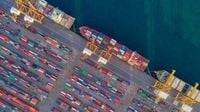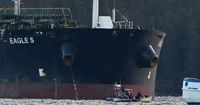On August 11, 2025, Finnish authorities made headlines across Europe and beyond by charging the captain and two senior officers of the Eagle S, a tanker tied to Russia’s so-called “shadow fleet,” with aggravated criminal mischief and aggravated interference with communications. This rare prosecution marks the first criminal case in a NATO country over a spate of recent sabotage incidents targeting critical infrastructure in the Baltic Sea, underscoring mounting regional anxieties about maritime security and geopolitical gamesmanship.
According to statements from Finland’s National Prosecution Authority, the captain, first officer, and second officer—whose names have not been publicly released—stand accused of deliberately damaging five subsea cables between Finland and Estonia by dragging the ship’s anchor along the seabed for nearly 90 kilometers (56 miles) in December 2024. The damage was not minor: the cables in question are lifelines for electricity transmission and telecommunications, linking not only Finland and Estonia but also facilitating broader connections between Nordic, Baltic, and central European nations. The Estlink-2 power cable alone can supply about half of Estonia’s electricity needs during winter, according to the Associated Press.
The incident’s financial toll is staggering. The owners of the damaged cables have already suffered repair costs totaling at least 60 million euros (about $69.7 million), as reported by multiple outlets including the Financial Times and ABC. The disruption posed a serious risk to energy supply and communications in Finland, though, as Finnish authorities clarified, alternative connections prevented any outright blackout. Still, the damage did drive up energy prices across the Baltic region, a ripple effect felt by households and businesses alike.
The Eagle S itself is emblematic of a growing problem for European security. Registered in the Cook Islands, the vessel is widely considered part of Russia’s “shadow fleet”—a collection of aging tankers with opaque ownership structures and a penchant for flying flags of convenience. These ships are designed to evade Western sanctions, especially those imposed after Russia’s 2022 full-scale invasion of Ukraine, and to move Russian oil covertly, often without Western-regulated insurance. The European Union added the Eagle S to its sanctions list in May 2025, reflecting the vessel’s role in circumventing economic restrictions aimed at Moscow.
The events leading up to the charges read like a maritime thriller. In December 2024, Finnish authorities, suspecting the Eagle S of causing the cable damage, boarded and seized the ship. Special border guard troops abseiled from a helicopter onto the deck, and the vessel was escorted to the port of Porvoo for a technical investigation. The crew—nationals of Georgia and India—were initially detained but later released on the condition that they remain in Finland while legal proceedings unfolded. In March 2025, Finnish officials permitted the Eagle S to depart the country, but by then, the criminal case was already gathering steam.
The suspects, for their part, have denied all charges. They maintain that the damage was unintentional and argue that Finland lacks jurisdiction because the incidents occurred outside Finnish territorial waters, in what they describe as international waters. If convicted, the men face up to 13 years in prison, a potential sentence that reflects the gravity with which Finland and its NATO partners view attacks on critical infrastructure.
The case has fueled a debate among Baltic Sea politicians and security experts. Some see in the Eagle S incident evidence of a coordinated Russian campaign to undermine Western infrastructure and sow instability. Others, however, suggest that the damage could be the result of poor seamanship or substandard vessel maintenance, pointing to a broader problem of aging ships and lax oversight in the shadow fleet. The Kremlin, for its part, has denied any involvement in the cable damage, insisting that Moscow had nothing to do with the incidents.
Regardless of intent, the stakes are high. The undersea cables and pipelines crisscrossing the Baltic Sea are the arteries of Europe’s energy and communications networks. Their vulnerability has become a matter of urgent concern. In January 2025, NATO allies bordering the Baltic Sea convened to discuss the surge in sabotage incidents, pledging to “enhance NATO’s military presence in the Baltic Sea,” as reported by the Financial Times. The alliance has also begun reviewing its legal frameworks to better detain and prosecute ships suspected of such attacks, a response prompted not just by the Eagle S but also by other incidents, like the Chinese vessel Yi Peng 3, which was accused of severing two cables in November 2024 but evaded Swedish inspection.
The shadow fleet, as described by Finnish customs officials and the European Union’s executive commission, represents a new and evolving threat to maritime and environmental security, not only in the Baltic but globally. These ships, operating in the gray areas of international law and commerce, challenge the ability of nations to protect their infrastructure and enforce sanctions regimes. As one NATO statement put it, “Russia’s use of the so-called shadow fleet poses a particular threat to the maritime and environmental security in the Baltic Sea region and globally.”
For Finland and its neighbors, the damage to the Estlink-2 and other cables is a wake-up call. The cables themselves are feats of engineering—the Estlink-2, for instance, stretches about 145 kilometers (90 miles) and plunges to depths of 90 meters (295 feet). Their failure, even if temporary, can send shockwaves through energy markets and disrupt the daily lives of millions. While this time, alternative connections kept the lights on, the incident has highlighted just how precarious Europe’s infrastructure can be in an era of heightened geopolitical rivalry.
As the legal proceedings move forward, attention is turning not only to the fate of the Eagle S crew but also to broader questions about deterrence and resilience. Will tougher legal measures and enhanced military patrols be enough to safeguard Europe’s underwater lifelines? Or will the shadow fleet continue to outmaneuver regulators and sanctions, leaving critical infrastructure at risk?
One thing is clear: the prosecution of the Eagle S officers is more than just a courtroom drama. It’s a test case for Europe’s ability to respond to new forms of hybrid warfare and economic sabotage—one that will be watched closely from Helsinki to Brussels, and from Moscow to Washington.
The story of the Eagle S, its shadowy voyage, and the cables it left in its wake is a vivid reminder that in today’s interconnected world, the battle for security often plays out beneath the waves, where anchors can do as much damage as armies.






